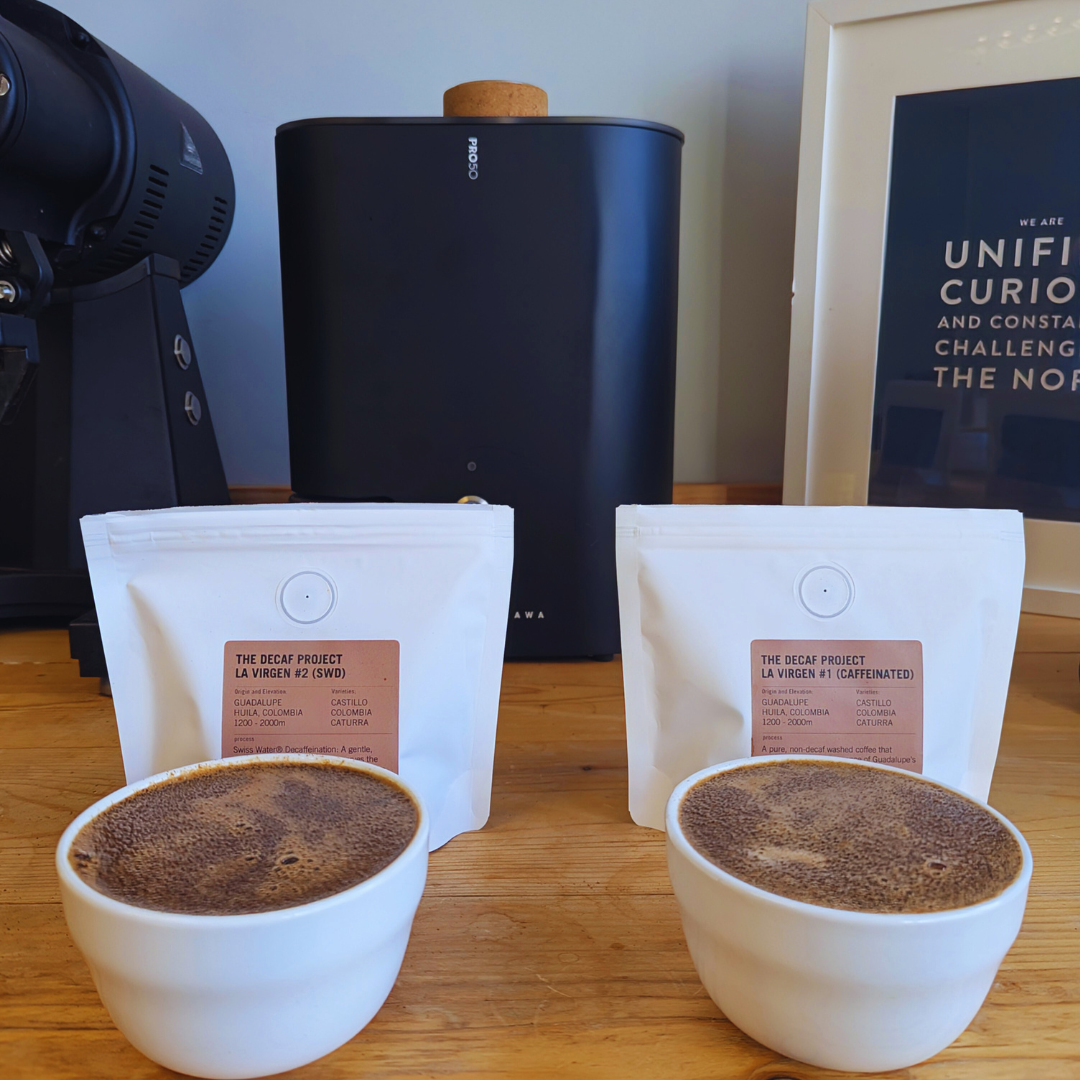The Decaf Project
When it comes to decaf, the conversation often starts with misconceptions: “Does it taste good?” or “Isn’t it just a compromise?” Decaf coffee often sits in the shadows of its caffeinated counterpart, with myths lingering about its quality and flavour. However, people are drinking more decaf than ever. The Decaf Project, led by coffee legend James Hoffmann in collaboration with Caravela Coffee, aimed to challenge these preconceptions—and we couldn’t resist taking part in it. Also, for the fun!
After buying a tasting kit, roasted by our friends at Crankhouse Coffee in Exeter (thanks, Dave!), we dove headfirst into this ground breaking coffee experiment. It is also one of the largest live cuppings ever undertaken in coffee history.
What Is The Decaf Project?
This was a coffee experiment like no other. The project sourced 16 tonnes of coffee through Caravela Coffee from La Virgen, Colombia, splitting it into four lots. One lot remained caffeinated, while the other three were sent to different decaffeination facilities:
- Swiss Water Process (Canada): A solvent-free method that removes caffeine using only water.
- EA Sugarcane Process (Germany): Uses Ethyl Acetate as a solvent, derived from sugarcane, to selectively remove caffeine.
- Carbon Dioxide Process (Germany): Uses liquid CO₂ to extract caffeine while preserving other flavour compounds.
These coffees were then distributed to 50 roasters worldwide, each roasting the samples for their communities to taste. The result? An unprecedented opportunity to explore how decaffeination impacts coffee flavour.
Our Cupping Experience
We cup daily at Voyager – as a way to understand flavour, check quality, and train our palates. It’s also highly subjective (although we try to be objective)—what one person tastes, another might miss. We were excited to explored the differences between the decaf methods and compare it to the caffeinated coffee. We have recently switched from Swiss Water to the EA Sugarcane Process for our own decaf coffee, so our curiosity to compare findings in the roastery was high. It has been amazing to experience how each method can bring out unique characteristics and change the unprocessed cup.
Here’s How Our Session Unfolded:
- Aroma Check: We began by smelling the dry grounds and the crust after pouring water. Surprisingly, the aroma differences between the coffees weren’t as pronounced as we expected.
- Breaking the Crust: At the four-minute mark, we stirred the coffee gently, releasing a burst of aroma.
- Slurping: This may look funny, but slurping sends tiny coffee particles to our retro nasal receptors, allowing us to detect subtle flavour notes.
- Tasting: We started with the caffeinated sample to establish a baseline, then moved through the three decafs.
What We Found
Here’s how the coffees compared to us and James Hoffmann during his live cupping. We cupped prior to the live session and then revisited the coffees after watching it:
- Caffeinated: A clean, fruity cup with balanced sweetness and gentle acidity.
- Carbon Dioxide Process: We found a lighter body and slightly thinner mouthfeel. James described it as “delicate,” and we agree—it felt like a pared-down version of the caffeinated sample.
- EA Sugarcane Process: Fuller-bodied with noticeable sweetness and vibrant aromatics. We noted more depth and clarity, aligning with James’s observation of fruitier, sweeter notes.
- Swiss Water Process: To us, it seemed darker and flatter, with muted fruit notes. James Hoffman mentioned this process seemed more impacted by the roast profile than the decaffeination itself.
Interestingly, our preference leaned towards the EA process. Bias plays a huge role in cupping—after all, we roast an EA processed decaf coffee ourselves, and we love it. This is why blind cupping is a critical tool for evaluating coffee objectively.
One key takeaway from watching the live cupping was how the roasting process plays a significant role, sometimes overshadowing the decaf method. The same coffee, roasted by different people, can produce dramatically different results.
What We Learned
The Decaf Project showcased how much effort and innovation go into decaffeination. Far from being a compromise, decaf can be vibrant, complex, and exciting. As James noted, the differences between the processes weren’t drastic—showing us that decaf coffee can truly stand up to caffeinated coffee.
For us, the EA Sugarcane Process stands out, and we see similar characteristics in our own decaf offering. This method preserves sweetness and clarity, creating a cup that’s as enjoyable as any caffeinated coffee.
- Subjectivity: Coffee tasting is personal. What you taste might differ from what we taste, and that’s the beauty of it.
- Roasting is Critical: The biggest variation often came from the roast profile, not just the decaf method.
- Rediscovering Decaf: this project reinforced that decaf coffee can taste great and deserves its place in the spotlight.
Final Thoughts
The Decaf Project was a joy to be part of, offering us a chance to taste, learn, and reflect on the incredible journey coffee takes—from origin right through to the roastery. If you’re curious, we highly recommend checking out James Hoffmann’s live tasting here The Decaf Project
Curious about decaf? Read more about how coffee is decaffeinated on our blog here: How is Coffee Decaffeinated
